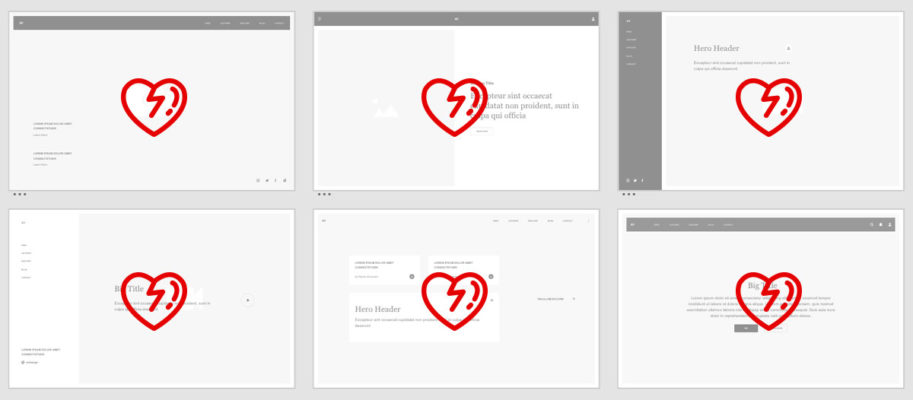Breaking up with a design is never easy. UX designers know that it takes a lot of work, time and searching to find the perfect design and it’s not uncommon to get attached to a particular concept. The design process is often full of many ups and downs. As the project progresses, you may find that you’ll always have a special bond with a particular design. You’ve spent countless hours crafting a design and it’s not uncommon to explore many designs before settling down on a particular approach.
Sometimes it’s easy to see that a design is clearly wrong for the project. However, sometimes there isn’t anything particularly wrong with the design. It just isn’t working and something feels off. When it comes to design solutions, it’s important not to settle. As UX designers, we’re all searching for that special design, one that suits the project perfectly.
Common design-breakup scenarios
Things can happen fast when designing. Suddenly you’re on cloud nine and in love with a design. It only makes sense since you’re spending a lot of time together thinking about the future and what exciting things lie ahead. You’re picturing new features, how components of this design will look in a design system, and how the relationship with this design will grow with the UI.

Sure, sometimes designs work out, and maybe this is the one. But what if it isn’t? It’s important to be aware of potential design issues and how this will impact the relationship. In many cases, the design isn’t the right match. Being aware of the three most common break up causes and how to best get through the breakup process, will get you closer to finding “the one”.
Scenario one: You need approval
You’ve probably been through this scenario before with a design. The future is looking bright and the design seems to meet all of the requirements. The design is absolutely perfect. You’re so happy and want to introduce the design to your product owner, project team, and all the stakeholders that are important for the approval process. You’ve even gone so far as to introduce it to your users. That’s when things get really serious!
It’s important to know that not all designs work out and those that are the closest to us often see red flags in the design that we may not. For example, the project stakeholders may find that it doesn’t align with the requirements and things don’t look as good as they once did after careful evaluation of the design. During a usability session, you may have witnessed some conflict with the design and maybe you didn’t want to admit it at the time. Maybe it wasn’t as intuitive and easy to navigate as you initially thought. After some clarity, you’ve come to the conclusion that this design isn’t the perfect match after all and it’s time to part ways.
Getting the approval that you need
After careful consideration, you’ve decided that in order to find a new design that will be approved, you’ll need to say goodbye to the current design. Before you start seeing other design possibilities, it’s good to assess this design and acknowledge the good things about it. Maybe the design had great visual components? Will you miss the UI copy, which was very friendly and funny?

It’s important to keep sight of the traits that you’re looking for in the next design. One that both you, the project stakeholders, and your users love. Take some time for yourself; the design break-up process can be very painful. It’s important not to get serious with another design until you’ve fully recovered. When you’re ready to meet other design options, ones that are sure to be approved, remain hopeful and optimistic during the process.
Scenario two: Designs change, and you two just grew apart
You used to open Adobe XD and feel butterflies when just looking at the design. Somehow, the desirable design seems to have lost its magic. One day you’re spending all day with the design and then the next day you feel like you haven’t seen the design in ages. Things get hectic. Maybe you find that you’re constantly shuffling back and forth from meetings all day long and don’t get to spend as much time with the design as you used to. Sometimes priorities change and the design is no longer needed. Often, other designs are keeping you occupied at the moment.
It’s only natural to distance yourself from this design. If it seems like there is no way to get back to the good times, it’s time to shift priorities and focus on another design.
It’s not you, design, it’s me
Maybe the design process has been long, with little outcome, and the design effort has run its course. It’s better for both of you if you end things now. Even if you love a design, you must let it go. This is where you, the UX professional, take ownership of the breakup. It’s your fault for not giving the design the attention that it deserved. Let the design down gently and remember all of the good times that you spent with the design.
Scenario three: Let’s just be friends
You know right where to find this design file. In fact, you often get inspiration from this design. However, no matter how hard you try to convince yourself that it works, it just isn’t the right design for the project. No question about it, you want to keep this design in your life since it has so many great qualities.
It happens to all designers from time to time. Sometimes with little warning, you lose interest after having a strong preference for a particular design. After careful consideration, you realize that you’ve moved too quickly and do not want to fully commit to this design.

Moving to the friend zone
Some UX professionals argue that once you break up with a design, it’s impossible to remain friends. It doesn’t have to be this way. The goal of the breakup should be to keep things, friendly and neutral. It’s not a traditional breakup because you’re not saying goodbye, you’re just changing the way you will interreact with the design in the future.
Designs change and it’s always normal to wonder “what if”. There’s always the fear of the unknown and wondering if a particular design was the design that got away? It’s important to design for the future and not remain in the past. Even if a design doesn’t work out, it’s important to get back out there and create the perfect design for your project.

Leave a Reply